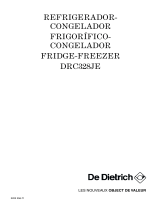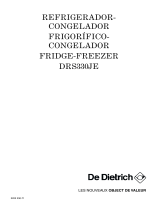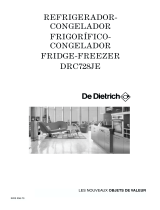16
ADVERTÊNCIAS E CONSELHOS IMPORTANTES
É muito importante que este manual de utilização acompanhe o aparelho para garantir uma futura utilização
correcta. Se o aparelho for vendido ou emprestado a uma outra pessoa, o manual de utilização deve, como
acima se faz notar, acompanhá-lo, de maneira que o utilizador possa ser informado do seu funcionamento,
das advertências e conselhos. Se este aparelho, munido de fecho magnético, veio substituir um outro que
tinha portas com fecho de mola, aconselhamos a inutilizar este fecho, antes do aparelho ser posto
definitivamente de lado. Esta precaução procura evitar que crianças, brincando, se possam fechar no
aparelho o que seria altamente perigoso.
Essas advertências têm por fim garantir a segurança dos utilizadores. Agradecemos, portanto, que leia o
manual atentamente, antes de instalar e utilizar o aparelho.
Segurança
• Este aparelho foi concebido para ser utilizado por
adultos. Deve, por isso, pô-lo ao abrigo das crianças
não consentindo que dele se sirvam como brinquedo.
• É perigoso modificar ou tentar modificar as
características deste aparelho.
• Este aparelho é pesado. Tenha o maior cuidado
quando o deslocar
• Não consuma certos produtos, tais como
gelados, imediatamente após terem saído do
aparelho; a temperatura muito baixa a que se
encontram pode provocar queimaduras.
• Este aparelho contém hidrocarbonetos no
circuito refrigerante; portanto, a manutenção
e a recarga devem ser efectuadas
exclusivamente por pessoal autorizado pelo
produtor.
• Preste a máxima atenção ao deslocar o
aparelho, para não danificar as partes do
circuito refrigerante, evitando assim possíveis
saídas de fluido.
• O aparelho não deve ser instalado perto de
elementos de aquecimento ou fogões de gás.
• Evite a exposição prolongada do aparelho aos
raios do sol.
• A parte de trás do aparelho deve receber uma
suficiente ventilação e deve ser evitado
qualquer dano ao circuito refrigerante.
• Somente para os congeladores (excepto os
de encaixe): a melhor colocação é na cave.
Assistência
• Se uma eventual modificação da instalação
eléctrica, na casa do utilizador, tiver de ser feita para
tornar possível a instalação do aparelho, deve, esta,
ser efectuada por pessoal qualificado.
• Este aparelho deve ser assistido por um Centro
de Assistência autorizado, sendo apenas
aplicadas peças de origem.
• Em caso de avaria, não tente você mesmo, reparar
o aparelho. As reparações executadas por pessoas
inexperientes, podem causar danos físicos e mate-
riais (aumentando as avarias a serem reparadas).
Faça apelo ao seu Centro de Assistência mais
próximo e insista em peças genuínas.
Utilização
• Os frigoríficos e/ou congeladores domésticos
destinam-se, unicamente, à conservação e/ou
congelação de alimentos.
• Os melhores rendimentos são conseguidos com
temperaturas ambiente incluídas entre +18°C e
+43°C (Classe T); +18°C e +38°C (Classe ST);
+16°C e +32°C (Classe N); +10°C e +32°C
(Classe SN); a classe a que pertence o aparelho
é indicada na placa de matrícula (posta na cela
ao lado do compartimento dos legumes).
Atenção: com temperaturas ambiente não
incluídas nas indicadas para a classe climática a
que pertence o produto, é preciso cumprir as
indicações seguintes: quando a temperatura
ambiente descer abaixo do valor mínimo, pode
não ser garantida a temperatura de conservação
no compartimento congelador; portanto,
aconselha-se a consumar rapidamente os
alimentos nele contidos.
• Um produto descongelado não deve, em nenhum
caso, voltar a ser congelado.
• Siga as indicações do fabricante para a
conservação e/ou congelação dos alimentos.
• O revestimento interior do aparelho em composto de
pequenos tubos por onde passa o refrigerante. Se
estes tubos forem danificados o aparelho ficará
irremediavelmente avariado, provocando a perda
dos alimentos no seu interior. NÃO UTILIZE
OBJECTOS PONTEAGUDOS para raspar o gelo
acumulado. Esse gelo pode ser raspado utilizando a
espátula. Para eliminar grandes quantidades de gelo
acumulado, é aconselhável deixá-lo derreter.Veja as
instruções para a descongelação.
• Não coloque no compartimento/congelador a baixa
temperatura, garrafas ou latas com bebidas
gaseificadas dado que se cria uma pressão elevada
no interior da garrafa e/ou lata havendo o perigo de
este explodir. Desta explosão resultariam danos
graves para o aparelho.
29
WARNINGS
It is most important that this instruction book should be retained with the appliance for future
reference. Should the appliance be sold or transferred to another owner, or should you move house
and leave the appliance, always ensure that the book is supplied with the appliance in order that the
new owner can be acquainted with the functioning of the appliance and the relevant warnings.
If this appliance featuring magnetic door seals is to replace an older appliance having a spring lock
(latch) on the door or lid, be sure to make that spring lock unusable before you discard the old
appliance. This will prevent it from becoming a death-trap for a child.
These warnings are provided in the interest of safety.You must read them carefully before installing or
using the appliance.
General Safety
• This appliance is designed to be operated by
adults. Children should not be allowed to tamper
with the controls or play with the product.
• It is dangerous to alter the specifications or
modify this product in any way.
• Before any cleaning or maintenance work is carried
out, be sure to switch off and unplug the appliance.
• This appliance is heavy. Care should be taken
when moving it
• Ice lollies can cause frost burns if consumed
straight from the appliance.
• Take utmost care when handling your
appliance so as not to cause any damages to
the cooling unit with consequent possible
fluid leakages.
• The appliance must not be located close to
radiators or gas cookers.
• Avoid prolonged exposure of the appliance to
direct sunlight.
• There must be adequate ventilation round the
back of the appliance and any damage to the
refrigerant circuit must be avoided.
• For freezers only (except built-in models): an
ideal location is the cellar or basement.
• Do not use other electrical appliances (such
as ice cream makers) inside of refrigerating
appliances.
Service/Repair
• Any electrical work required to install this
appliance should be carried out by a qualified
electrician or competent person
• This product should be serviced by an authorized
Service Centre, and only genuine spare parts
should be used.
• Under no circumstances should you attempt to
repair the appliance yourself. Repairs carried out
by inexperienced persons may cause injury or
more serious malfunctioning. Refer to your local
Service Centre, and always insist on genuine
spare parts.
• This appliance contains hydrocarbons in its
cooling unit; maintenance and recharging must
therefore only be carried out by authorized
technicians.
Use
• The domestic refrigerators and freezers are
designed to be used specifically for the storage
of edible foodstuffs only.
• Best performance is obtained with ambient
temperature between +18°C and +43°C (class T);
+18°C and +38°C (class ST); +16°C and +32°C
(class N); +10°C and +32°C (class SN). The
class of your appliance is shown on its rating
plate.
Warning: when the ambient temperature is not
included within the range indicated for the class
of this appliance, the following instructions must
be observed: when the ambient temperature
drops below the minimum level, the storage
temperature in the freezer compartment cannot
be guaranteed; therefore it is advisable to use the
food stored as soon as possible.
• Frozen food must not be re-frozen once it has
been thawed out.
• Manufacturers’ storage recommendations should
be strictly adhered to. Refer to relevant
instructions.
• The inner lining of the appliance consists of
channels through which the refrigerant passes. If
these should be punctured this would damage the
appliance beyond repair and cause food loss. DO
NOT USE SHARP INSTRUMENTS to scrape off
frost or ice. Frost may be removed by using a
plastic scraper. Under no circumstances should
solid ice be forced off the liner. Solid ice should be
allowed to thaw when defrosting the appliance.















